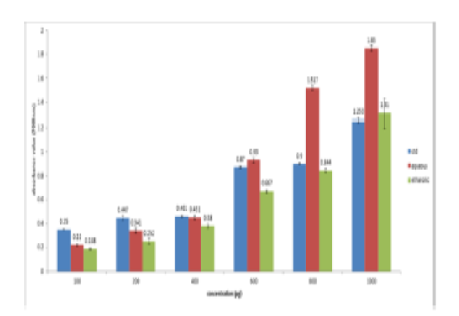


Journal of Pharmaceutical Research
Year: 2025, Volume: 24, Issue: 2, Pages: 83-88
Original Article
Shalini Singh1, Ashsis Sapkota1, Mahak R Chetri1, Prabika Rai1, Gayatri Thapa1, Ananya Bhattacharjee2,∗
1Department of Pharmacology, Himalayan Pharmacy Institute, Majhitar, 737136, East Sikkim, India
2Associate Professor, Pharmacology Department, Himalayan Pharmacy Institute, Rangpo, Majhitar, 737136, East Sikkim, India
*Corresponding Author
Email: [email protected]
Natural source being a valuable resource of medicine, Christella acuminata (fern), is considered in the present study, where its ethanolic and aqueous leaf extracts were examined for phytochemical screening, antibacterial activity, antioxidant activity, and anti-inflammatory activity. The presence of phytoconstituents was determined by different phytochemical screening methods. Various concentrations (100-1000µg/ml) of the sample extracts were examined for their anti-bacterial activity by Disc Diffusion Method, anti-oxidant activity by Ferric ion Reducing Anti-oxidant Power (FRAP) assay, and anti-inflammatory effect by Egg Albumin denaturation assay. The presence of various phytochemicals like alkaloids, flavonoids, polyphenols, steroids, and saponins was positive. The efficacy of antibacterial activity of the extracts was observed as the zone of inhibition of bacteria around the discs relative to streptomycin and the zone of inhibition was found to be the highest in an ethanolic extract with the recorded values of 2.35±0.02mm and 2.14±0.02mm for gram-positive and gram-negative bacteria respectively whereas the ferric reducing antioxidant power was observed highest in an aqueous extract with recorded values of 1.8566 ± 0.021.The percentage inhibition of egg albumin denaturation showed the highest activity in an ethanolic extract, with recorded values of 89.7 ± 0.09 %. These results suggest that the ethanolic and aqueous leaf extract of Christella acuminata can be a potent source in drug discovery for improving inflammation, and oxidative stress and treating bacterial infections. Since no previous study is reported for this plant extract as per we know, further detailed studies may be carried out for better insights.
Keywords: Ferns, Anti-bacterial, Anti-oxidant, Anti-inflammatory, Glaphylopteriolopsis
© 2025 Published by Krupanidhi College of Pharmacy. This is an open-access article under the CC BY-NC-ND license (https://creativecommons.org/licenses/by-nc-nd/4.0/)
Subscribe now for latest articles and news.